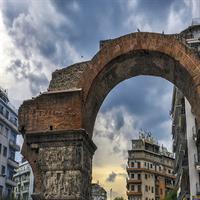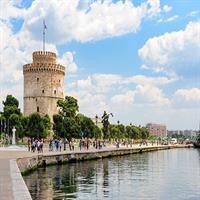Day 1 in Thessaloniki
Welcome to Thessaloniki! Upon arrival, you will go
through customs and immigration. Should you opt to purchase a transfer to your
hotel; a representative will be waiting for you as you exit immigration. Arrive
at your hotel, check in and do not give in to jet lag! There is so much for you
to see and do!
Start your day at the waterfront of Thessaloniki,
easily one of the most festive anywhere in Europe. The promenade is alive with
restaurants, bars, boutiques, cafes and sights. This is a great place to grab
some lunch and get your bearings of the city.
Take a stroll along the 3 mile long waterfront trail, feel the
pulse of the city, see historical sights and the more artistic side of the
city. View the 20 ft tall monument of Alexander
the Great riding
his horse `Voukefalas`, one of the
most famous horses of antiquity. Further along the boardwalk, you’ll see
the `Umbrellas`, by Greek sculptor
Giorgios Zoggolopoulos. Award-winning, it consists of a static group of
floating umbrellas that stand 42 ft tall. It is easily
one of the most photographed pieces in the city.
While you`re near the water, head up the historic six-storey White Tower, the
iconic symbol of Thessaloniki. The Tower was used by the Ottoman Turks as
a fortress and a prison. In 1826, at the order of the Sultan Mahmud II, there
was a massacre at the tower and in turn, it acquired the name `Tower of Blood`. When
the city was taken over by the Hellenic State, the tower was whitewashed, a
symbol of cleansing and rebirth. These days the White Tower is open to the
public and is home to exhibits and a timeline illustrating the city`s history.
Head to the roof and enjoy the lovely vistas.
Continue
on familiarizing yourself even more by following the old city walls off-the-beaten-track. It`s like taking
a trip back in time and experiencing what the city used to look and feel like.
The city itself has been fortified since the 4th-century. The walls
are a late Roman style construction consisting of ashlar masonry and brick.
As the
evening approaches head to the Upper
Town, also known as the Old Town. It`s the part of the city that survivied the
Great Fire of 1917. Upper Town features the city`s rich past, traditional and
preserved structures from a time long ago, including small stone-paved streets,
charming squares and houses in both greek and Ottoman architecture.
At the
top of Old Town sits the Acropolis
of Thessaloniki. Inside the Acropolis, you`ll discover the Heptapyrgion, the city`s main (Seven Tower) fortress.
It`s a great place to learn about the city`s past all while
enjoying stunnings views of the entire area. You`ll also find lovely
cafes, restaurants and taverns around the fortress, a great spot to relax over
a delicious dinner and take it all in. You`ll notice the entire area in the old
Thessaloniki district comd alive at night as bars, restaurants and clubs open
up and close at dawn.




Day 2 in Thessaloniki
Rise and shine! Grab some breakfast
before heading out for more exploration on the second-largest city in Greece.
Start your day at the Roman Forum,
also known as `Ancient
Agora`, located just a few blocks away from aristotelous
square in the middle of the city. The Forum (Agora) was constructed
by the Romans in the late 1st-century AD. Along with the Galerian
Palace Complex it was the center of political and public life in
Thessaloniki. Visiting the Forum is a great chance to step back in time, it is
well preserved and provides you an idea of the Roman period in the city.
After, head over to Agios Dimitrios Church and Crypt, a
UNESCO site just a short distance from the Roman Forum. This gorgeous church is
awe-inspiring. Dimitrios is a patron saint of Thessaloniki, so a lot of
attention was paid to make this church as majestic as possible. There are lots
of amazing artifacts to see and a serene place to reflect and pray.
Next, spend some time at the historic
house museum of Atatürk.
The house is the
birthplace of the founder of modern Tukey, Mastafa Kemal Atatürk, who was born
here in 1881. He is considered one of the most important and historic
personalities of Turkey. The house has three floors and a courtyard with most
of the furnishings and personal objects inside the house being authentic.
Enjoy some time discovering the Rotunda, another UNESCO site
in the city, it was built in 306 A.D by the Romans. The building has a circular
plan, which is sometimes covered by a dome. The Rotunda is quite similar to the
Pantheon in Rome in that it has an oculus on the top. Both Rotundas have been
built in Roman times and one in Thessaloniki has gone through different
stages, it used to be a temple, a Christian basilica, a Muslim mosque, a
Christian church and it is now a monument. This is a must see for ancient
history buffs!
Lastly, end your afternoon at the Archaeological Museum, one of
the largest museums in Greece and the one of the most beautiful and important
museums of the city. Due to the city`s rich Ancient Greek, Roman and Byzantine
history the museum hosts a variety of exhibits that will impress every visitor.
Offering beautiful samples of Roman archeticture, unique colorful mosaics,
sculptures and jewellery from the Greek Classical and Hellnistic period.
Also, the Byzantine Museum is just a
short walk from the Archaeological Museum. The museum is packed with incredible
artefacts - collections of sculpture, frescoes, mosaics, icons and inscriptions
from the Byzantine period. It`s brilliantly laid out and cleaverly designed to
lead you through the different ages of the Byzantine period.
After a busy day of sightseeing, we
recommend taking in a play or concert at one of the city`s many theaters,
concert halls, and nighclubs with live entertainment. Grab dinner at any of the
numerous taverns and ouzo restaurants throughout the city. If you`re trying to
taste the cuisine of Thessaloniki you must order Soutzoukakia and have some
pita and yogurt with it – delicious! A great spot to go is the Ladadika district, the
ultimate area for night entertainment. The pedestrian area is flooded with
sounds from all musical trends, as well as many restaurants and bars.


-893868-200.jpg)
Day 3 in Thessaloniki
On your last day in Thessaloniki,
this is the day to take advantage of being on vacation and spend some time
strolling, wandering, and browsing. Start your day by
taking in the city`s markets:
the Modiano, the
open-air food market on Athonos Square, the Kapani (Vlali) is
the oldest open market of the city, and Bezesteni markets, which all blend into
each other. A walk in thess
market is a chaos of senses overload that will make you feel the spirit of
the city. Expect to see colorful spices from all over the world, find items that
you didn`t know existed and inhale aromas that will make you want to sample
everything you see.
Enjoy the rest of your day browsing
through some of the shops and galleries along Eganatia, Tsimiski, Aristotelous, Ayias Sofias, and
pedestrinized Dimitriou Gounari
streets.
Tsimiski Avenue in the heart of
Thessaloniki, it contains many boutiques, fashion shops,
delicatessens and large bookstores amongst other things. `Plateia`
(Plaza) shopping mall, with the famous `Odeon` multiplex cinemas, is also
located on Tsimiski Avenue, near Aristotelous Square. Moreover, Tsimiski Av.
hosts many large and impressive department stores like `Nottos Galleries`. If
lucky, you may discover some brand names at real bargain prices here. While
walking this Avenue you`ll most likely be accompanied by live music, since many
local and some foreign less known bands perform on Tsimiski Avenue.
When you`ve
finished shopping and wandering through the city, head to the waterfront
for sunset to enjoy your last dinner at one of the many beautiful restaurants
located here.


Additional Days in Thessaloniki
Should you be able to spend additional
days in Thessaloniki, you may want to head out
of the city to see some of the sites elsewhere. About 50 miles southwest of Thessaloniki, Mount
Olympus is the highest mountain in Greece. It features in Homer`s Iliad
as the home of the gods, who were known as the Olympians. This mighty massif
covers an area of about 12 miles across and
climbs steeply towards the summit, reaching its highest point in Mítikas at 1.8 miles. Though the highest ridges are difficult to climb, the most
northerly peak offers easier access. South of Mount Olympus, the Vale
of Tempe is where the river Piniós (Peneios) flows to the sea and is
the principal route into central Greece from the north.
Nature lovers may also want to visit Lake Vistonida
near the town of Porto Lagos, about a two-hour drive from
Thessaloniki. This wetland area attracts vast flocks of migrating birds and is perfect
for bird watching with more than 300 different species recorded here.
Alternatively, if the
weather is nice, you may want to do as the locals do and enjoy a relaxing day
at the beach. Epanomi
is a great sandy beach easily accessible by bus. Agia Triaa is another beach (about 40 minutes away) that
is a Blue Flag beach. The Halkidik
Peninsula, a popular holiday spot, famed for its turquoise
waters, is located furthest east, but definitely doable for a day trip (about
1.5 hours away).


Your Last Day in Thessaloniki
Depart your hotel for the airport for your return home. We recommend that you purchase a private transfer, if so a representative will meet you at the hotel, in time to take you to the airport for your flight out.
